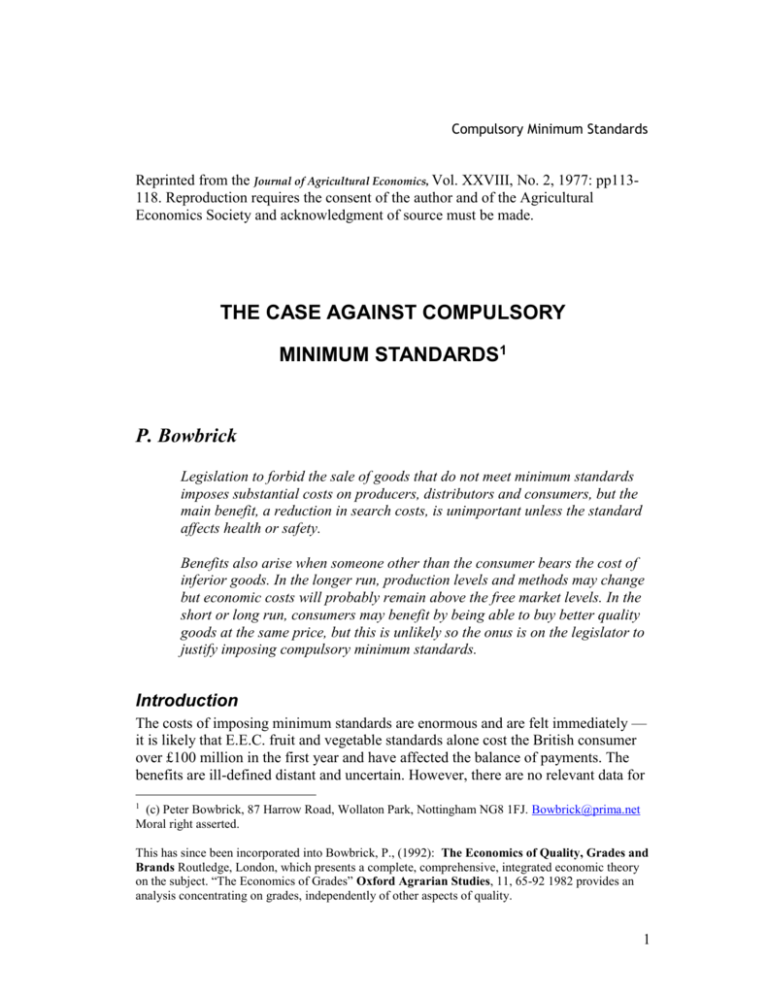The case against minimum standards
advertisement

Compulsory Minimum Standards Reprinted from the Journal of Agricultural Economics, Vol. XXVIII, No. 2, 1977: pp113118. Reproduction requires the consent of the author and of the Agricultural Economics Society and acknowledgment of source must be made. THE CASE AGAINST COMPULSORY MINIMUM STANDARDS1 P. Bowbrick Legislation to forbid the sale of goods that do not meet minimum standards imposes substantial costs on producers, distributors and consumers, but the main benefit, a reduction in search costs, is unimportant unless the standard affects health or safety. Benefits also arise when someone other than the consumer bears the cost of inferior goods. In the longer run, production levels and methods may change but economic costs will probably remain above the free market levels. In the short or long run, consumers may benefit by being able to buy better quality goods at the same price, but this is unlikely so the onus is on the legislator to justify imposing compulsory minimum standards. Introduction The costs of imposing minimum standards are enormous and are felt immediately — it is likely that E.E.C. fruit and vegetable standards alone cost the British consumer over £100 million in the first year and have affected the balance of payments. The benefits are ill-defined distant and uncertain. However, there are no relevant data for 1 (c) Peter Bowbrick, 87 Harrow Road, Wollaton Park, Nottingham NG8 1FJ. Bowbrick@prima.net Moral right asserted. This has since been incorporated into Bowbrick, P., (1992): The Economics of Quality, Grades and Brands Routledge, London, which presents a complete, comprehensive, integrated economic theory on the subject. “The Economics of Grades” Oxford Agrarian Studies, 11, 65-92 1982 provides an analysis concentrating on grades, independently of other aspects of quality. 1 Peter Bowbrick most industries and, since a theoretical model must be extremely complex to apply to real-world situations, justification is impractical. The E.E.C. and many governments have legislated to forbid the sale of goods that do not meet certain minimum standards. No theoretical examination of the effect of imposing minimum standards has been published, much less any attempt to justify them by applying the theory to the facts. I discuss here a product which is sorted into three grades, Class I, Class II and Class III, and which is clearly labelled, and I consider what happens when the sale of Class III is forbidden. I assume that all consumers would prefer Class I to Class II and Classes I and II to Class III if the prices were the same. I do not ask here whether the grade specifications are optimal, whether compulsory grading is desirable, or what labelling is desirable. I do not challenge the view that individual producers must grade for efficient marketing.2 Market period In the market period the effect of forbidding the sale of Class III is to reduce the total supply and to change the price of the other grades by an amount which depends on the income elasticity of demand, the quantity of Class III, the elasticities of substitution between the classes and the rate of substitution between each class and all other products. If the grades are relevant to consumers, the effect of changing the supply of Class III is different from the effect of a similar change in quantity spread equally over all grades, so the normal elasticities of demand are irrelevant. In the market period all consumers are worse off because of the higher price of Classes I and II. Those whose optimum purchase was Class III, frequently people in the low income groups, suffer most, as they have both to buy a less desirable grade and to pay a higher price, and social costs may arise. The imposition of a minimum standard reduces search cost. This can be of immense value when it refers to the consumers’ health — the safety of electrical apparatus or the hygiene of food for instance — though a warning on the label is considered sufficient for cigarettes. When some less important attribute is considered and Class III is clearly labelled, there can be little reduction in search costs; indeed the higher price gives the consumer more incentive to search, so the search cost may rise. Defects in labelling systems and consumer use of labelling systems have been discussed widely in the last few years but are not directly relevant to this discussion. Minimum standards may also be imposed when people other than the consumer suffer the costs of poor quality, especially danger and pollution, or where the state does not wish to bear the cost of treating self-inflicted injuries, those from drinking methylated spirits for instance. When the minimum standard is based on an irrelevant 2 Clearly the model applies equally to a situation with any number of grades. If one has five, say, the first approximation would be made by combining Classes II, III and IV into the Class II discussed here. The next step of separating out the different effect on Class II and Class IV introduces complications, but does not change the broad thrust of the argument. 2 Compulsory Minimum Standards attribute, consumers have to pay higher prices but do not benefit in any way from the withdrawal of a class. When the sale of Class III is forbidden, retailers may get a higher or lower revenue, depending on the cross-grade effect and their policy on margins. Those retailers who sold mainly Class III probably lose a lot of trade; and social costs arise if for instance they are mainly small family shops or neighbourhood shops. Fixed costs per item sold rise and there is a fall in variable costs, though this is generally small. Procurement costs fall. Handling costs fall if retailers only have to handle two grades instead of three, but as a rule they handle only one or two grades however many are available. Waste may fall but it will not if stale or sub-standard Class I and II must be dumped rather than being marked Class III. Retailers incur increased supervision costs. The change in retailers’ costs is not likely to be passed on to the consumer in the market period or short run. Wholesalers sell less at a higher price. If they sell on commission, their gross revenue may increase or decrease depending on the cross-grade elasticity. If they buy and sell, their gross revenue depends on this and on their market power. The individual wholesalers who sell mainly Class III will be worst affected. Fixed costs per unit of throughput increase. The wholesaler dealing with a highly perishable product like fruit and vegetables loses the flexibility gained from being able to sell over-mature Class I as Class III. It may take the wholesaler less time to sell the uniform Class I and Class II than to sell the mixture of classes that ends up in Class III, and this may reduce his variable costs. In the market period, overcapacity may lead to higher wholesaling costs per unit sold. Administration costs also rise. The total revenue of producers may or may not rise when Class III is banned, depending on whether the increase in average price is greater than the fall in quantity. Fixed and variable costs per unit sold increase. It is probable that those firms that produce mostly Class I and II benefit and that those who produce mostly Class III are worse off. Frequently it is the small family farms with very low incomes or the small rural industries that produce mainly Class III and are slow to change. If these are forced out of business by a minimum standard, the social and economic consequences are far-reaching. Price (1967) has shown that it can pay producers to restrict the supply of the lower quality even when demand for the product is elastic. His model assumes that an increase in the culling rate improves the quality of all grades, by removing the smaller cherries from all grades alike for instance, so that both the reduced supply and the improvement in quality of the existing classes increase the price. In my model, where one grade is banned and the specifications of the other grades are unchanged, this effect does not arise. Waugh (1971) shows that it is not necessarily the most profitable option to withdraw the lowest grade: in many cases the industry could gain more from withdrawing Class I or some of each class. Government must negotiate the minimum standards, legislate, inform the users of the new regulations, provide inspectors at producer, wholesale and retail levels, warn offenders and prosecute persistent offenders. These costs are negligible in relation to the costs incurred by other sectors. 3 Peter Bowbrick Short run In the short run it may be expected that supplies will increase and prices will fall below the market-period level, so consumers will not be as badly off as in the market period. Those consumers who previously bought Class III will be worse off. In the long run consumers’ tastes may change and they will no longer accept Class III. With the current resource crisis, it could be argued that it is morally wrong to change tastes so that people prefer a more expensive product. In the short run retailers and wholesalers, particularly those who formerly sold mainly Class III, sell less and may go out of business so a smaller quantity is sold by fewer firms, which may lead to a rise or fall in turnover per firm. Those retailers who built up a reputation for quality may get a lower premium for this when Class III is removed. Consumers frequently judge quality by price, assuming that the more expensive items are better, but this implies that some cheap items, Class III, are available for comparison. The total supply is affected in several ways in the short run. Some of those firms who produced large proportions of Class III switch to other products or go out of business, so the Class I and IL they produced is no longer on the market. Other producers, especially those producing mainly Class I, use their capital at a greater intensity and produce more. Producers also have greater incentive to change their techniques, producing more Class II and less Class III, as the return from improving an item from unsaleable to saleable is greater than that from improving it from a saleable Class III to Class II. If there were economies of scale to be obtained when producing only Class I, but not when producing three classes, minimum standards might reduce costs in the long run. However, since similar economies of scale might also arise when producing Classes II or III, a maximum standard might be equally justified. The economies of scale might be open only to large producers, so the minimum standard could be a means of structural reform, of forcing out small producers. It could also be a means of bringing about centralised marketing, if, for example, the standards required large grading plants. Minimum standards are sometimes used to protect home producers from competition; for instance E.E.C. tomato grading regulations can be used to protect the Northern European glasshouse industry from competition from Southern European outdoor tomatoes. Maximum standards are sometimes used in the same way, as when it is forbidden to add yellow dye to margarine, so it will be a less close substitute for locally produced yellow butter. It is sometimes argued that the chief reason for poor quality is bad management and that firms will improve their production methods if Class III must be discarded. This is assumed to have little or no cost; indeed when better quality is associated with higher yields, as is often the case in agriculture, it is assumed that there will be a clear benefit to all concerned. If the policy did work and all Class III 4 Compulsory Minimum Standards was upgraded to Class II, at little or no extra cost, there would be a reduction in the price of Class I and Class II below the previous levels, and Class I, Class II and some Class III customers would be better off, though some Class III customers would still be worse off. The fact that entrepreneurs produce Class III even when they could earn more by producing only Class I, suggests that they do not think the extra money compensates for working harder and with more attention to detail. It is worth considering the political and social implications of forcing a man to work harder for a return that is unlikely to be bigger in the long run, when the economic benefits to society are doubtful. Even if quality could be improved at no extra cost, one could not assume that this would be done just because minimum standards are introduced. Some producers go out of business or switch to other products rather than submit to what they consider to be mindless bureaucracy — a reaction particularly common among farmers. Others find that the increased price and the reduced quantity gives them the same income so there is no incentive for them to change their production methods. The more efficient producers, often those who produce a high percentage of Class I anyway, are likely to respond to the increased price by increasing production to the point where marginal cost equals marginal revenue, and so increasing production cost. Poor quality need not be due to bad management. It may well suit the farmer to produce large quantities of Class III and to dispense with sorting. The decision faced by the producer is extremely complex and, in horticulture at least, it is seldom possible for the producer to calculate his optimum sorting plan, though sometimes he may find a position that is clearly not far wrong. No outside observer could have any grounds for saying that the farmer is not adopting an economically optimal plan. Still less could anyone say that all farmers are mistaken in producing Class III. In imposing a minimum standard, the state must also allow for the market effects described above, which will alter the marginal return from sorting. It is sometimes argued that producers adjust their production according to the demand curve facing the firm rather than the market demand curve, and that if a market supply reduction can be managed by means of a minimum standard they will obtain monopoly profits. While this is true in the market period its effectiveness in the short run or long run depends on there being some form of supply restriction e.g. quotas. It is generally uneconomic to export low-quality products, so exporting countries usually consume Class II and Class III at home and export Class I. If the importing country sells Class III and has a low price for Class I and II, imports will not be high. If Class III is forbidden in the importing country, supply on the market falls and Class I prices rise, so there will be imports of Class Ito fill the gap. For this reason restriction of home production may not increase producers’ Class I price much even in the market period and may reduce per acre return substantially. Even if the exporting country does not have the advantages of favourable climate cheap labour or cheap fuel, it has the advantages of lower unit costs, because it sells all grades at home, not just Class I and II; it can build up a highly organised distribution system; and it can use discriminating monopoly: these advantages often compensate for the higher transport costs. The importing country with minimum standards is 5 Peter Bowbrick choosing to compete in the grade where transport costs give it least advantage. Exporting countries have to make similar decisions to those of the farmer and they frequently impose minimum standards for exported products, so that no one can damage the reputation of, say, Danish bacon by selling inferior bacon, or of Israeli celery by selling inferior Israeli melons. Practical problems The practical problems of forecasting the effects of legislation to impose minimum standards or evaluating the effects of standards already imposed are insurmountable. One cannot forecast the effect of removing a substantial quantity of a product, all from one grade, particularly if, as with horticulture in the E.E.C., similar minimum standards are applied simultaneously to all close substitutes. Long run supply responses cannot be estimated from experience of farmers’ response to short run price changes. Lack of statistical data, mislabelling (which is common), and insufficient identification makes econometric analysis impossible in most markets. What minimum standards? The impact of the minimum standards depends largely on their specifications. It is most unlikely that category specifications which are optimal when three grades are marketed will also be optimal when the bottom grade is thrown away. The minimum standard may specify minimum or average levels of perhaps twenty or forty attributes and it may set down tolerances. If the specification for any one of these attributes is changed the supply, demand and cross elasticities for all classes will change. If the specifications for several attributes are changed at the same time the result is impossible to forecast. If any one of the attributes is not relevant to any group of consumers then any increase in the level of the specification increases the price without increasing their satisfaction. The more attributes that are specified in a minimum standard the more likely it is that several will be irrelevant to a large proportion of customers. When the customers have different tastes, particularly in the E.E.C. where regulations apply to all sales in nine countries, one can expect that different attributes are irrelevant to different groups of customers, and that the English working class pays high prices because the standards list attributes of interest only to the German or French professional classes. Conclusion I have given here the bones of an analysis which would have to be adapted and expanded to allow for the circumstances peculiar to any industry. It is obvious that 6 Compulsory Minimum Standards the theoretical and practical problems of justifying any minimum standard are enormous. It is also obvious that the immediate costs are likely to be very high when any substantial amount of the product is Class III. The long-term costs may not be so high, but in practice they cannot be forecast. The benefits, except, for a few goods, those of public health and safety, are vague and insubstantial, difficult to conceive theoretically and more difficult to measure. One cannot say, from an outline of the theory and no data, whether minimum standards are justified in any case. One can say though that many of the costs are certain, immediate and large while all the benefits are uncertain and distant and may be small, so the onus is upon the legislator to justify his action with facts, theory and hard analysis. In fact, I know of no case where this has been done, and I know of one major European country which introduced minimum standards on a wide range of products without consulting an economist. If the amount of a horticultural product that does not meet minimum standards is only 10 per cent (and it is much higher for many products) the immediate effect of E.E.C. minimum standards was to increase prices by over 10 per cent, as inelastic demands are more common for this commodity group, and as many products in the commodity group were affected at the same time. Britain spends £1,000 million a year on horticultural products affected by these standards so an immediate cost of over £100 million a year was incurred for no obvious benefit. References Price, D. W. (1967). Discarding Low Quality Produce with an Elastic Demand, J. Fm Econ. 49, 622—632. Waugh, F. V. (1971). Withholding by Grade, Am. J. agric. Econ. 53, 500—501. 7





